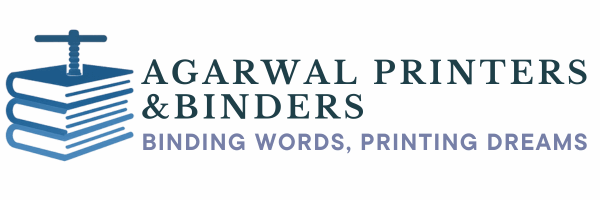
Printing your book is a huge milestone. Whether it’s your debut novel, a corporate handbook, a coffee table collection, or a family memoir, holding that finished copy in your hands is a truly special moment. But successful book printing requires careful planning, and small mistakes can lead to costly results.
The journey from manuscript to finished book involves many technical steps and small oversights can lead to costly mistakes or disappointing results.
At Agarwal Printers & Binders, we’ve been book printing and binding books for over 40 years. In that time, we’ve seen many clients run into avoidable problems. So today, we’re sharing the most common mistakes people make when printing books and how you can steer clear of them.
1. Submitting Files That Aren’t Truly “Print-Ready”
This is by far the most frequent issue.
Many people think a high-quality PDF or Word file is enough, but print-ready files have specific requirements:
- Correct color mode: Print requires CMYK, not RGB (which is for screens).
- High resolution: Images should be at least 300 DPI to print clearly.
- Bleeds and margins: If your design goes to the edge, you need to extend it beyond the trim line (usually by 3mm).
- Embedded fonts: Without this, your fonts might default to something else, ruining your layout.
Always ask your printer for their file specs—and ideally, have a graphic designer prepare your final files.
Without these, your printed books may look very different from your screen version.
2. Forgetting About Spine Width
If you’re doing a perfect bound (like most paperbacks) or hardcover book, the spine width is critical.
It depends on your total page count and paper thickness. Guess wrong, and your cover text won’t align—or worse, the cover won’t fit at all.
Ask your printer to calculate the exact spine width before you finalize your book cover design.
3. Choosing the Wrong Paper or Binding
One of the biggest book printing mistakes is paper selection, not all paper is the same.
- Glossy paper is great for photo-heavy books, but can cause glare in text-heavy novels.
- Uncoated paper is perfect for novels or workbooks but may dull photo colors.
- Thicker paper feels premium but makes the book bulkier (and more expensive to ship).
Similarly, binding matters: spiral binding is excellent for manuals that need to lay flat, while casebound hardcovers give a luxury feel. Discuss your goals with your printer so they can recommend the best options.
4. Skipping the Proofing Stage
Never skip proofs in book printing, this is a dangerous shortcut.
A printed proof (even a single copy) lets you catch:
- Typos you overlooked on screen
- Images that print darker or lighter
- Pages that get too close to the edge
- Unexpected color shifts
It’s much easier (and cheaper) to fix at this stage than after printing hundreds of copies.
5. Ignoring Trim & Safe Zones
Every book is trimmed to size after printing. If your text or images sit too close to the edge, they risk being cut off.
Use a safe margin (usually at least 5-7mm inside the trim line) to keep everything important safely inside.
6. Underestimating Time & Delivery
- High-quality book printing takes time—especially if you’re doing custom finishes like embossing or foiling. Add to this the shipping or courier time to your location.
- Plan backward from your launch or event date. Talk to your printer early to set realistic timelines, and always leave a buffer for unexpected delays.
- Special finishes like lamination, spot UV, embossing, or textured covers make your book stand out. But they also affect the print process, costs, and timelines.
If you decide on these late, it might be too late (or too expensive) to include them. Discuss all finishing options at the start.
Final Thoughts: Print Smart, Print Proud
Your book is more than pages bound together—it’s your story, your brand, your hard work. Avoiding these common mistakes ensures that the final product does justice to your vision.
At Agarwal Printers & Binders, we guide clients through every step of the book printing process—from file setup to binding—so your book is something to be proud of.
📞 Have a book project in mind?
We’d love to help. Get in touch for a free consultation or a sample quote. Your story deserves the best print.
For more printing tips, design inspiration, and behind-the-scenes updates, follow us on Instagram
